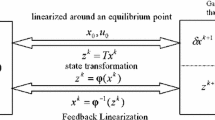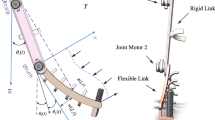Abstract
Our previous works have shown that an enhanced plant Jacobian is helpful to improve the control performance of the inverse dynamic neural controller. This paper further studies this control scheme by using stochastic configuration networks (SCNs) and Savitzky–Golay (SG) filter, which can be used to produce higher quality of Jacobian teaching signals. It is observed SCN-based modeling techniques with reduced noise of estimated Jacobian can make the tracking performance favorably. Convergence and stability analysis of the closed-loop system are given. Comprehensive simulations are carried out, and results clearly demonstrate the effectiveness of our proposed method.













Similar content being viewed by others
References
Fei J, Wang T (2019) Adaptive fuzzy-neural-network based on RBFNN control for active power filter. Int J Mach Learn Cybern 10(5):1139–1150
Shu Y, Liu X, Wang F et al (2018) Exponential input-to-state stability of stochastic neural networks with mixed delays. Int J Mach Learn Cybern 9(5):807–819
Wang Y, Wang M, Wang D et al (2022) Stochastic configuration network based cascade generalized predictive control of main steam temperature in power plants. Inf Sci 587:123–141
Psaltis D, Sideris A, Yamamura A (1988) A multilayered neural network controller. IEEE Control Syst Mag 8(2):17–21
Liu Z, Su Z, Ji Z (2018) Neural network observer-based leader-following consensus of heterogenous nonlinear uncertain systems. Int J Mach Learn Cybern 9(9):1435–1443
Zhang Y, Chai T, Wang D (2017) An alternating identification algorithm for a class of nonlinear dynamical systems. IEEE Trans Neural Netw Learn Syst 28(7):1606–1617
Saerens M, Soquet A (1991) Neural controller based on back-propagation algorithm. IEEE Proc Control Theory Appl 138(1):55–62
Zhang Y, Sen P, Hern G (1995) An on-line trained adaptive neural controller. IEEE Control Syst Mag 15(5):67–75
Wang D, Soh C (2000) Adaptive neural model-based decentralized predictive control. Int J Syst Sci 31(1):119–130
Wang D, Bao P (2000) Enhancing the estimation of plant Jacobian for adaptive neural inverse control. Neurocomputing 34(200):99–115
Wang D (2008) Modeling performance enhancement with constrained linear filters. In: The 2008 IEEE international joint conference on neural networks. China, Hong Kong, pp 698–702
Wang D, Li M (2017) Stochastic configuration networks: fundamentals and algorithms. IEEE Trans Cybern 47(10):3466–3479
Pao Y, Takefuji H (1992) Functional-link net computing: theory, system architecture, and functionalities. Computer 25(5):76–79
Wang D (2016) Editorial: randomized algorithms for training neural networks. Inf Sci: 364-365
Yan A, Guo J, Wang D (2022) Robust stochastic configuration networks for industrial data modelling with student’s-t mixture distribution. Inf Sci 607:493–505
Dai W, Ning C, Nan J, Wang D (2022) Stochastic configuration networks for imbalanced data classification. Int J Mach Learn Cybern 13(10):2843–2855
Savitzky A, Golay M (1964) Smooth and differentiation of data by simplified leastsquares procedures. Anal Chem 7:1627–1639
Lancaster P, Tismenetsky M (1985) The thory of matrices, 2nd edn. Academic Press, New York
Funding
This work is funded by the National Key R &D Program of China under Grant 2018AAA0100304
Author information
Authors and Affiliations
Corresponding author
Ethics declarations
Conflict of interest
The authors declare that they have no conflict of interest.
Additional information
Publisher's Note
Springer Nature remains neutral with regard to jurisdictional claims in published maps and institutional affiliations.
Rights and permissions
Springer Nature or its licensor (e.g. a society or other partner) holds exclusive rights to this article under a publishing agreement with the author(s) or other rightsholder(s); author self-archiving of the accepted manuscript version of this article is solely governed by the terms of such publishing agreement and applicable law.
About this article
Cite this article
Dang, G., Wang, D. Stochastic configuration networks for adaptive inverse dynamics modeling. Int. J. Mach. Learn. & Cyber. 14, 3529–3541 (2023). https://doi.org/10.1007/s13042-023-01848-z
Received:
Accepted:
Published:
Issue Date:
DOI: https://doi.org/10.1007/s13042-023-01848-z




